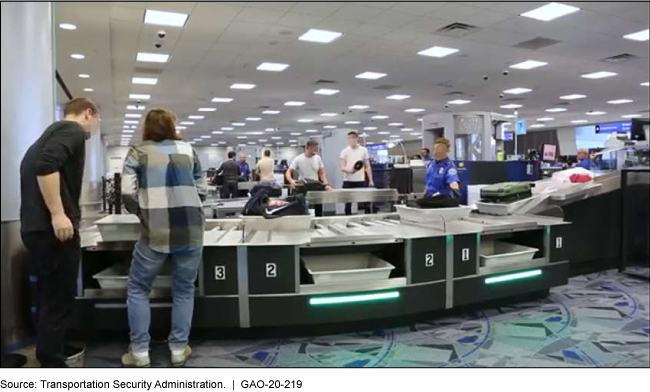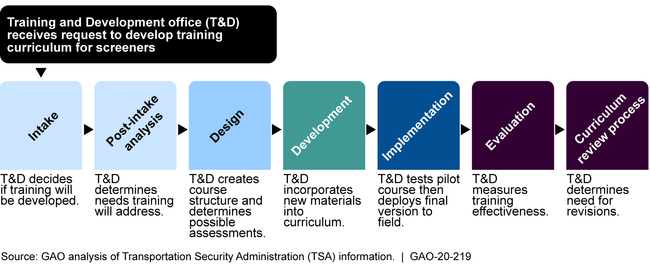Aviation Security: TSA Updated Screener Training to Address Risks, but Should Enhance Processes to Monitor Compliance
Fast Facts
TSA screens millions of airline passengers and their bags each day at commercial airports. To do so effectively, it requires its screener workforce to complete trainings on screening procedures and technologies. TSA has updated these trainings in recent years to keep up with emerging threats.
However, we found that TSA has not documented its process for monitoring whether its screeners are taking these required trainings. The agency also hasn’t looked at its training data across years to identify trends that may require action.
We recommended that TSA document its process and analyze screener compliance data across years.
TSA Screeners Working at an Airport Security Checkpoint

TSA security line
Highlights
What GAO Found
Since 2015, the Department of Homeland Security's (DHS) Transportation Security Administration (TSA) developed and updated screener training to address potential risks to commercial airports identified through covert testing and reports on emerging threats. From May 2015 through June 2019, TSA identified 62 potential risks that warranted review for a potential change in training. TSA made training changes in response to 56 of the identified risks—affecting 40 different training courses. TSA also responded to risks by developing or updating job aids or briefings for screeners.
TSA uses established models for developing, updating, and evaluating its screener training. The figure below shows TSA's process for updating and evaluating its screener training, in accordance with a training development model that is widely accepted and used across the federal government.
Transportation Security Administration's (TSA) Screener Training Development Process

TSA relies on an online database to monitor screener compliance in completing required training at the nation's commercial airports. However, TSA has not documented its process for monitoring screener training compliance, including for analyzing compliance data and reporting and addressing instances of noncompliance at airports. Moreover, while TSA monitors airport compliance rates in a given year, it does not analyze the data across fiscal years for potential trends in noncompliance by individual airports that may warrant corrective action at the headquarters level. GAO found that in fiscal years 2016 and 2017, screeners at 435 commercial airports met TSA's 90 percent target compliance rate, while in 2018, five airports had compliance rates well below this target, dropping 15 to 26 percentage points from the prior year. TSA officials stated they were unaware of this development. By documenting its screener training compliance monitoring process and monitoring screener training compliance data across fiscal years, TSA would be better positioned to ensure it is aware of potential noncompliance trends warranting corrective action at the headquarters level.
Why GAO Did This Study
TSA is responsible for screening millions of airline passengers and their baggage each day at the nation's commercial airports for items that could threaten aircraft and passengers. In carrying out its mission, TSA requires its screener workforce to complete various trainings on screening procedures and technologies. TSA updated its security screening procedures and technologies in recent years to address risks identified through covert tests in 2015 and reports of emerging threats.
The TSA Modernization Act of 2018 included a provision for GAO to examine the effectiveness of TSA's updated screener training. This report addresses: (1) changes TSA made to screener training since 2015; (2) how TSA updates and evaluates screener training; and (3) how TSA ensures screener compliance with training requirements.
GAO analyzed TSA documentation on training development, compliance monitoring, and a non-generalizable sample of six recently updated training courses—selected to reflect a range of training types and topics. GAO also reviewed TSA data on airport screener training compliance rates from fiscal years 2016 through 2018, and interviewed TSA officials.
Recommendations
GAO is making two recommendations, including that TSA (1) document its process for monitoring screener training compliance and (2) monitor screener compliance data across fiscal years. DHS concurred with the recommendations.
Recommendations for Executive Action
| Agency Affected | Recommendation | Status |
|---|---|---|
| Transportation Security Administration | The TSA Administrator should direct T&D and Security Operations to document their processes for monitoring TSO training compliance—including those for analyzing training compliance data, reporting the results from their analysis, and actions taken to address the results. (Recommendation 1) |
In February 2020 , we reported that the Transportation Security Administration (TSA) had developed and updated screener training since 2015 to address potential risks to commercial airports identified through covert testing and reports on emerging threats. However, we found that the TSA had not documented its process for monitoring screener training compliance, including for analyzing compliance data and identifying and addressing instances of noncompliance at airports. We recommended that TSA's Office of Training and Development (T&D) and Security Operations, the two entities within TSA responsible for monitoring training compliance, document their processes for monitoring screener training compliance, including analyzing compliance data, reporting the results of their analysis, and actions taken to address the results. In response, in May and June 2020, the two offices documented its processes for monitoring screener training compliance. Specifically, in May 2020, T&D developed, documented, and implemented a new Standard Operating Procedure on their training compliance process. Further, in June 2020, T&D and Security Operations collaborated to document responsibilities at the field and headquarters levels for monitoring training compliance, as well as actions taken to address the results. Specifically, the two documents outline the processes by which training compliance data will be analyzed , how results of the analysis will be reported , and how corrective actions will be determined to address the results. As a result, TSA is better positioned to ensure it aware of potential screener training noncompliance trends warranting corrective action at the headquarters level. These documents fulfill the intent of our recommendation.
|
| Transportation Security Administration | The TSA Administrator should direct T&D and Security Operations to monitor for instances of TSO non-compliance by individual commercial airports across fiscal years that could potentially warrant corrective action at the headquarters level. (Recommendation 2) |
In February 2020, we reported that the Transportation Security Administration (TSA) had developed and updated screener training since 2015 to address potential risks to commercial airports identified through covert testing and reports of emerging threats. We found that while TSA monitors airport training compliance rates in a given year, it does not analyze the data across fiscal years for potential trends in noncompliance by individual airports that may warrant corrective action at the headquarters level. For example, we found that in fiscal years 2016 and 2017, screeners at 435 commercial airports met TSA's 90 percent target compliance rate, while in 2018, the compliance rates for five of those commercial dropped 15 to 26 percentage points from the prior year. TSA officials stated they were unaware of this development. We recommended that the TSA Administrator direct the Office of Training and Development (T&D) and Security Operations (SO) to monitor for instances of non-compliance by individual commercial airports across fiscal years that could potentially warrant corrective action at the headquarters level. TSA concurred. T&D implemented an iShare training compliance reporting repository to capture and analyze training compliance data. In February 2020, TSA officials reported that they began sharing monthly reports on training compliance with SO to allow T&D to recognize trends at individual commercial airports and specific training courses throughout the fiscal year. In July 2021, TSA officials provided us examples of its monthly reports as well as analysis comparing training compliance rates across fiscal years and reported their plans to continue doing so moving forward. As a result of these efforts, TSA is better positioned to determine whether any instances of screener training noncompliance it identifies constitutes a trend warranting headquarters-level corrective action.
|
